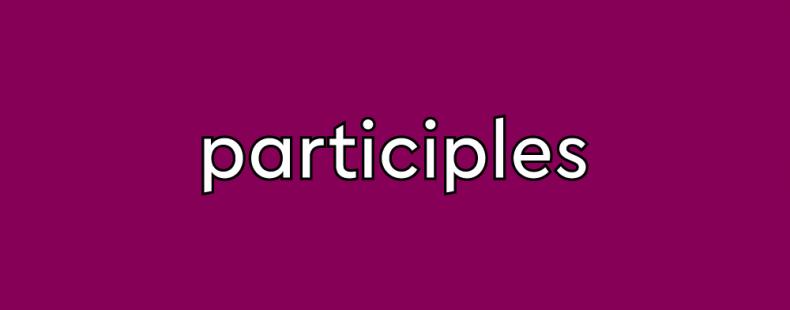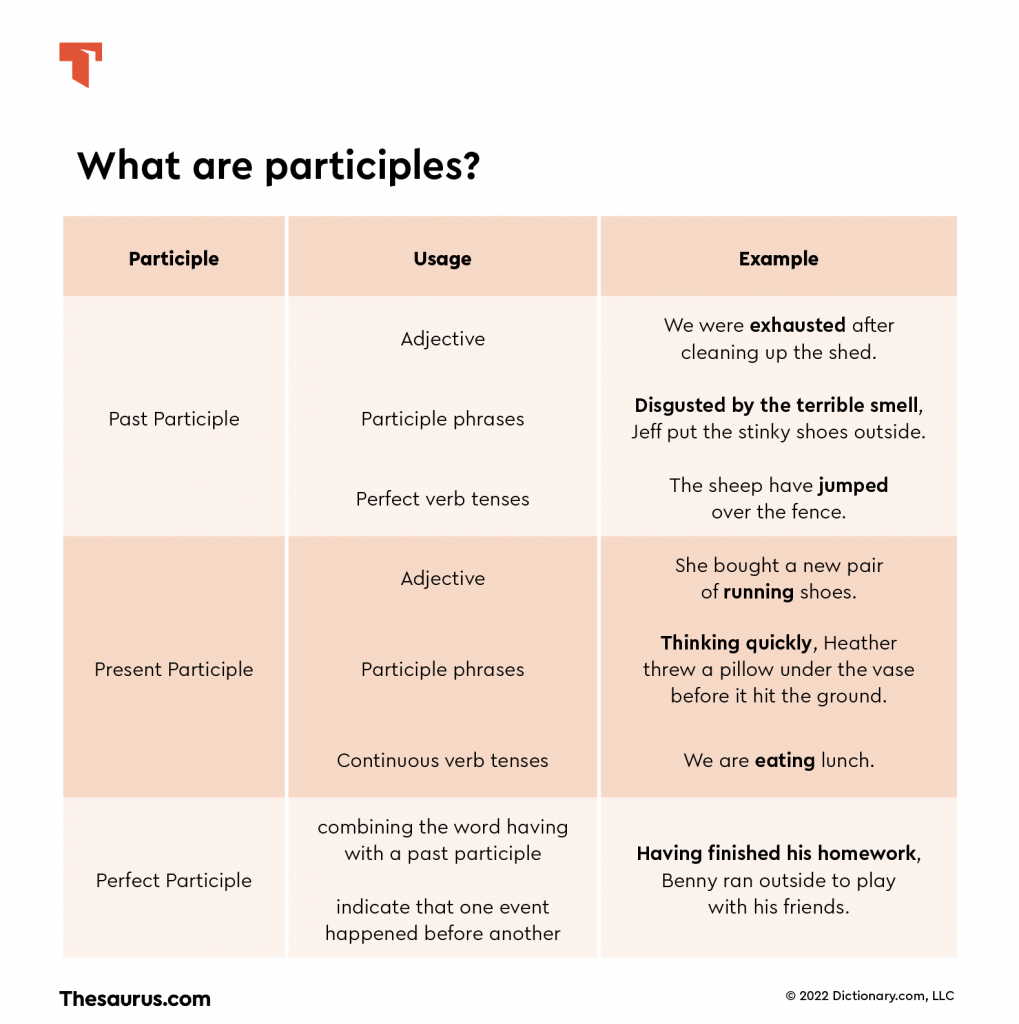Ah, participles. The magical part of speech that looks like a verb but often acts like an adjective. They can be perfect. They can be continuous. Is there anything they can’t do? Well, they can’t teach you grammar, but, lucky for you, that won’t be a problem. We’ll teach you grammar—and all about participles!
So you might have heard the word participle before, but maybe you don’t know what it means. Or maybe you know what it means, but aren’t quite sure how to use those tricky participles. After all, participles are part of what makes those dang irregular verbs so frustratingly … irregular. Before we get ahead of ourselves, let’s learn more about what exactly a participle is.
What is a participle?
A participle is a type of word derived from a verb that is used for a variety of purposes, such as an adjective or to construct verb tenses. Participles themselves are considered to be a different part of speech than verbs, but they look a lot like the verbs they come from. For example, the verb walk can be turned into the participles walked and walking. If you are a verb expert, you’ll notice that those two words look identical to the past and present tense forms of walk. And you’d be right! We told you participles often look a lot like verbs. However, participles can do a bunch of jobs that verbs can’t and can help a verb express some complicated actions.
⚡️Participle examples
Before we get to the nitty-gritty, let’s look at some examples of participles used in sentences.
- The shelf was full of tantalizing treats.
- She has a backpack covered in stickers.
- He has been staring at that painting for hours.
- The Easter Bunny had hidden lots of eggs.
- Having reviewed the evidence previously, the detective was unconvinced of the suspect’s guilt.
Types of participles
According to most grammar resources, there are two major types of participles: present participles and past participles. A third “type” of participle, the perfect participle, is actually a combination of one specific present participle and a past participle. Let’s take a look at each of these types of participles to understand how we use them.
Past participles
Right off the bat, past participles can get pretty tricky depending on the verb you are dealing with. For regular verbs, a past participle is typically formed by adding -ed to the end of the root form of the verb, the form you’ll find if you look up a verb in our dictionary. For example, the past participle of kick is kicked. Even with regular verbs, though, there are often exceptions to this general rule, which you can learn more about in our detailed guide to past participles. Irregular verbs don’t follow this rule at all—for example, the past participle of eat is eaten.
So, what are past participles used for? In general, there are three major uses for past participles:
1. Adjectives: You can use a past participle as an adjective to modify a noun (or noun equivalent).
- We were exhausted after cleaning up the shed.
2. Participle phrases: A participle phrase is a longer adjectival phrase that uses a participle and other parts of speech to modify a noun (or noun equivalent).
- Disgusted by the terrible smell, Jeff put the stinky shoes outside.
3. Perfect verb tenses: Past participles are used to form the six perfect verb tenses. The perfect tenses use the helping verb have and a past participle, and the perfect continuous tenses also use the past participle of the verb be (been).
- Present perfect tense: The sheep have jumped over the fence.
- Past perfect tense: The sheep had already jumped over the fence.
- Future perfect tense: The sheep will have jumped over the fence by the time we arrive.
- Present perfect continuous tense: These sheep have been jumping over that fence since I started working here.
- Past perfect continuous tense: The sheep had been jumping over the fence for years before we built a bigger fence.
- Future perfect continuous tense: The sheep will have been jumping over that fence for hours by the time I fall asleep.
Past participle examples
The following two lists give examples of past participles.
- Regular verbs: acted, borrowed, hopped, mumbled, paused, studied, wandered
- Irregular verbs: caught, done, gotten, had, ridden, seen, understood, worn
Present participles
For the most part, present participles are easier to handle than past participles. To form the present participle of most verbs, you simply add -ing to the root form of the verb. For example, the present participle of show is showing. Of course, there are some exceptions to this general rule, which we explain in our guide to present participles. However, even irregular verbs play by the rules when it comes to present participles. For example, the present participle of the notoriously uncooperative verb be is being.
Present participles can do many of the same jobs that perfect participles can:
1. Adjectives: You can use a present participle as an adjective to modify a noun (or noun equivalent).
- She bought a new pair of running shoes.
2. Participle phrases: Present participles can be used in participle phrases, too.
- Thinking quickly, Heather threw a pillow under the vase before it hit the ground.
3. Continuous verb tenses: Like past participles, present participles are used to form six different verb tenses.
- Present continuous: We are eating lunch.
- Past continuous: We were eating lunch.
- Future continuous: We will be eating lunch for a little while yet.
- Present perfect continuous: We have been eating lunch for only a few minutes.
- Past perfect continuous: We had been eating lunch when the whistle blew.
- Future perfect continuous: We will have been eating lunch for only 10 minutes by the time the boss tells us to pack it up.
Present participle examples
The following list gives many examples of present participles.
- arriving, biting, carrying, doing, entertaining, flying, guessing, hoping, inching, jutting, kissing, learning, mixing, napping, opening, putting, quieting, running, seeing, talking, uncovering, visiting, waiting, xeroxing, yelling, zipping
Perfect participles
The term perfect participle doesn’t refer to a unique third type of participle, but a grammatical phrase formed by combining the word having with a past participle. Perfect participles are used to indicate that one event happened before another. For example:
- Having studied birds for years (happened first), Julie knew how to safely remove the owls from the attic (happened second).
Often, perfect participles are used to indicate that one action ended almost immediately before another started. For example,
- Having finished his homework, Benny ran outside to play with his friends.
Perfect participle examples
Perfect participles are formed by combining any past participle—including had—with the word having.
- having asked, having broken, having grown, having placed, having told, having worn
Review the difference between have and has, and when to use each one.
What is a participial phrase?
A participle phrase, also known as a participial phrase, is an adjectival phrase that includes a participle (past, present, or perfect) and other parts of speech, such as nouns, adjectives, adverbs, and prepositional phrases. Like adjectives, participle phrases are used to modify nouns and noun equivalents. Typically, a participle phrase is placed as close as possible to the noun that it is modifying so as to avoid confusion. For example,
- She was looking for a man wearing a red cowboy hat.
- Kenji ate three hot dogs slathered in ketchup and mustard.
Participle phrases can also come at the beginning of sentences. When they do, they are separated by the main sentence with a comma. As before, it is usually advised to place the modified noun as close to the participle phrase as possible to avoid confusion.
- Amazed by the magician’s tricks, the audience cheered and clapped.
- Mumbling to himself, Dave walked past me without saying hello.
What is a dangling participle?
A dangling participle is a participle or participial phrase that is either modifying the wrong noun or is modifying a noun that is missing from a sentence. Dangling participles are a common mistake that can be avoided by placing a noun as close as possible to the participle or participle phrase that is modifying it.
Here are two examples of sentences with dangling participles:
- Swooping with speed and precision, the grasshopper was snatched by the hawk. (The participle phrase seems to be modifying grasshopper when it is actually supposed to be modifying hawk.)
- Tired of the jester’s irritating jokes, the dungeon was the fool’s new home. (The participle phrase is modifying a word that is missing from the sentence; this participle phrase is describing a person who is not mentioned at all in the sentence.)
It is important to review your sentences carefully to make sure you don’t accidentally create a dangling participle. Let’s fix our two sentences to get rid of dangling participles.
- Swooping with speed and precision, the hawk snatched the grasshopper.
- Tired of the jester’s irritating jokes, the queen ordered the dungeon to be the fool’s new home.
Participles? Grammar Coach™ can help!
Improve your writing with Thesaurus.com’s Grammar Coach™, an online writing tool that catches grammar and spelling errors. Using machine learning technology, Grammar Coach™ can spot the difference between the different types of participles, their correct and incorrect uses—and much more! Perfect grammar has never been easier.
















